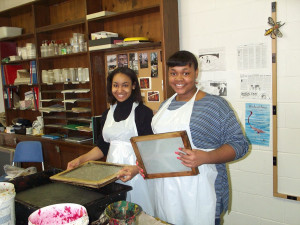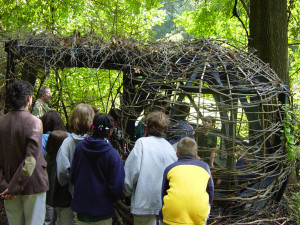By Mary Salvante
Editor’s note: 2015 marks the Schuylkill Center’s 50th anniversary along with the 15th anniversary of the art program. As part of our ongoing celebration of this milestone, we invited Mary Salvante, the founder of the art program, to write a reflection on the past 15 years.
Where does the time go? Seems like just recently I was visiting the Center for the first time. My first impression then was the notion that it would be a perfect location for an art program, and more specifically, an installation at the front entrance.
In 1999, the Schuylkill Center had just completed its first 10-year master plan and included in it was the recommendation that the Center diversify its programming to bring in new audiences. With that goal in mind, I approached the director at the time, Tracy Kay, and proposed an art program as one strategy for attracting new visitors. We began slowly with exhibitions in the front gallery while putting together grant applications for funding of larger initiatives such as the artists in residence program and outdoor temporary art exhibitions.
From the beginning I felt it important that the art program be mission-driven and relate to the education mission of the Center. The premise was that the art program would address the same issues being taught in science curriculum as an extension of the classroom, while the outdoor exhibitions provided an opportunity for personal introspection. It was the artist in residence program though where the intersecting of art and education was the most apparent, since it required an instructional component for students from area schools.

Jane Allen was our first artist in residence, and with a grant from the Mid Atlantic Arts Foundation, she worked on site for several weeks. Jane made paper from organic materials that were gathered from the grounds of the Center. She and students from area schools collected the seeds and nuts and grasses and as they did they identified them by their botanical names and nomenclature.

Knox Cummin was our next artist in residence and his project was much more immersive with students. The Green Woods Charter School was on site at this point, giving the artist consistent access to the entire student body and faculty. The planning of his project was done in collaboration with the charter school teachers and administration, and course work was created the integrated the art project into other academic areas including science, math, and writing. We learned a lot from that process and perhaps the take away was how vital it is to include all the stakeholders in the planning process in order to establish buy-in and cooperation. By planning a year ahead, teachers could integrate the topic areas into the curriculum for the year. Knox worked with students to understand the dynamics of an ecological site. Topics were inspired by guest speakers that focused on a particular area of concern such as erosion, impact, invasive species in the landscape, and amphibious life in streambeds. Each team of students created sculptures and wrote a statement about why that subject was selected. Different facets of the project were worked on in writing, science, and math classrooms.
While the artist in residence programs where active, we were also presenting temporary art on the trails of the Center. This component of the program was targeted for the casual visitor and adults that would not be attending educational programs. While walking the trails, they would come upon the art that was either made on site to address specific Schuylkill Center issues (such as invasives), or artists modified works to address ground water, habitat health, disappearance of green spaces, and more. The art installations also looked at historical narratives such as the agricultural history of the area, the wildlife, and sustainability.
Additional installations explored larger and more ephemeral aspects of nature such as how elements like wind, rain, and light, interacted with humans and objects. The projects were diverse and broad, but most important they were temporary and not meant to leave a trace on the landscape once removed. Our guidelines for this program were also unique in that it required artists to visit the Center and walk the trails so that they would be better informed about the landscape and the concerns that they would address in the artwork.
These projects and exhibitions would not have been possible without the support received from the William Penn Foundation and the National Endowment of the Arts that recognized the power of art to raise awareness of these important environmental concerns, while providing opportunities for the many artists that make social activism a core concern in their artistic practice. The projects were enriched by the many collaborations we did with area arts organizations such as Philadelphia Sculptors, InLiquid, and the Center for Emerging Visual Artists.
I hope in some small way the art program has advanced the goals of environmental awareness and stewardship.
About Mary Salvante
Mary Salvante has worked with professionals from public and private sectors on the planning and implementation of public and community art programs for over 20 years. She founded the Environmental Art Department at the Schuylkill Center in 2000, and currently serves as Gallery and Exhibitions Program Director at Rowan University.
